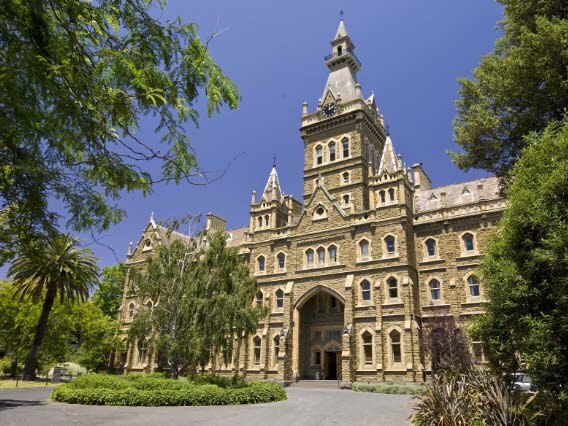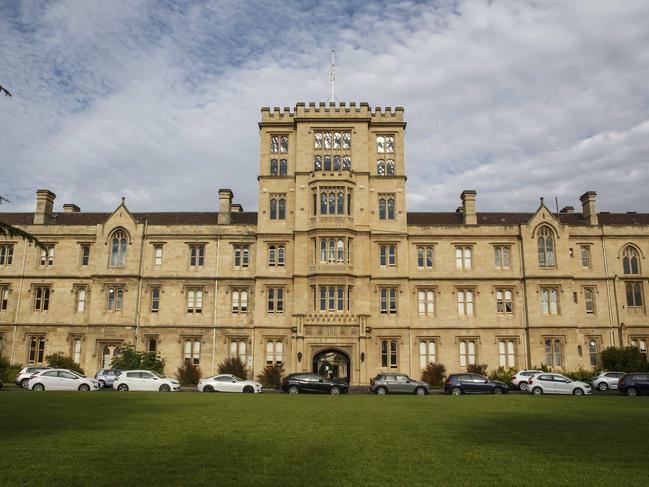Colleges on Melbourne university’s College Crescent are a proud throwback in time
Welcome to the world of Harry Potter-style dining halls, black-tie events and 24-hour tutors. This is what it's really like to live at Melbourne University’s residential colleges.

Education
Don't miss out on the headlines from Education. Followed categories will be added to My News.
The elite “big four” University of Melbourne colleges are Trinity, Queens, Newman and Ormond.
They’ve all faced criticism in recent years for being out-of-touch, “laddish” and dominated by private school kids from Kew, Toorak and Brighton.
Such colleges, which were established on land gifted to the Anglican, Presbyterian, Methodist and Catholic churches in the 1850s, offer an unparalleled level of academic support, wellbeing programs and extra-curricula activities.
But with fees averaging $34,000 a year, they don’t come cheap.

The older colleges based on the university’s northern perimeter on College Crescent are a proud throwback in time, with student dinners in academic gowns, oak-lined halls, art galleries, choirs, rowing regattas, black tie events, 24-hour tutors and in-house chefs offering three hot meals a day.
Even the relatively newer colleges of St Mary’s, St Hilda’s, University and Janet Clarke Hall have fees of around $25,000, putting them out of reach for most.
These days, the colleges hang onto traditions, but are keen to diversify their student bodies, and hand out a high number of scholarships on financial, academic and sporting grounds.
Trinity College
The most prestigious college at the University of Melbourne which features a Harry Potter-style dining hall, billiards room, visual arts studio and chefs serving up slow-cooked pork belly and mushroom risotto.
Some of the college’s events are legendary, such as the black tie El Dorado ball hosted by the college’s Wine Society. Tradition awards the “pink jacket” to one male prior to the ball for winning an “all-male drinking, running and wrestling event”.

The 2018 Neave report into Trinity College’s culture found a “high proportion” of students from elite private schools, including one in ten from Melbourne Grammar and only six per cent from state schools. The college has since worked hard on diversifying its intake and moving away from a “hyper-masculine” culture.
In recent years, the college has admitted students from more than 300 schools, although it continues to be strongly linked to Scotch College, St Catherine’s, Melbourne Grammar, Geelong Grammar and Melbourne Girls’ Grammar.
The college has also moved away from O-week hazing involving games such as “dead ants” and students being dunked in sludge.
Annual fees $35,000
Scholarships: $5000 to $30,000 for regional students, Indigenous students and general students. One third of students are on scholarships.
Movers and shakers: Margie Gillespie, Keri Whitehead, Kody Roth, Sandy Clark, Kirsten Gray, Professor Ken Hinchcliff, Richard Pickersgill, Leonie Jongenelis.
Alumni: Ronny Chieng, Gideon Haigh, Rob Sitch, Clive Baillieu, Robert Champion de Crespigny, Kay Goldsworthy, Manning Clark, Ken Myer, Will Alstergren, Yvonne Aitken, Lilian Helen Alexander, Gillon McLachlan
Ormond College
Ormond College has traditionally attracted kids from Anglican private schools and is well known for its lush grounds and historic buildings.
Ormond has also become known for its at-times troubled student culture and in 2018 it published a first-hand student account of being raped on campus. The student, who was supported by the college to go public with her story, referred to disclosures of sexual assault made to her by 15 other individuals at the college. The college’s culture was also the subject of a controversial 1991 book by Helen Garner called The First Stone.

One past student said of his time at Ormond: “Some of it was a bit odd, such as the Ormond student constitution which defines two gender categories – women and non-woman.” The body’s constitution defines the non-woman category as including “all those who do not (be they men, intersex, nonbinary, or any non-cis person who does not identify as a woman)”.
Annual fees: $34,000
Scholarships: Around one third of the students are on some form of financial assistance, and there is an extensive range of scholarships, especially for rural, Indigenous and disadvantaged students.
Movers and shakers: Andrew Michelmore, Davis McCaughey, Rufus Black, Peter Wade, Lara McKay.
Prominent Alumni: Sir Zelman Cowan, Kate Jenkins, Hilary Charlesworth, Ziggy Switkowski, Peter Singer, Sir Edward “Weary” Dunlop, Mark Seymour.
Newman College
Newman College is the Catholic college which has key buildings designed by Walter Burley Griffin in 1918. The last of the colleges to go co-ed, Newman has long been known as a “footy college with lots of Xavier boys”. It’s won more intercol premierships than any other college. Newman also has a range of soirees showcasing the artistic talents of students and has an art prize, a debating medallion and a chapel and concert choir.

The Catholic connections have meant the college has long attracted students from, not only Xavier but St Patrick’s in Ballarat, and St Kevin’s in Melbourne.
Fees: $27,000
Scholarships: In 2023, three-quarters of the college’s students were on scholarships, with more than $1m each year given to around 220 students.
Movers and shakers: Bill Lang, Frank Brennan, Guglielmo Gottoli, Rebecca Daley, Charlotte O’Shea, Alicia Deak.
Prominent Alumni: Kevin Andrews, Frank Brennan, Peta Credlin, Neale Daniher, Marg Downey, Frank Galbally, Sir James Gobbo, James Gorman, Brenda Niall.
Queen’s College
Queen’s College has retained the tradition of students wearing their academic gowns for a formal dinner in the dining hall on Monday nights. The “spoon-bang” is still observed with vigour at the start of formal dinners to celebrate the winning of Queen’s College teams in sports, cultural and academic competitions. The college’s coat of arms celebrates its Methodist traditions, and its Latin motto is aedificamus in aeternum, which means “We are building for eternity”.

The college, which one past student said was full of “smart, popular, sporty kids” attracts students from Melbourne Grammar, Wesley College, Toorak College and Methodist Ladies’ College. The student life of the college involves vigorous competition in the Intercollegiate Cultural Cup, college balls, dinner swaps and barbecues in the Quad. The college also produces an academic journal, has a student society called Willie Quick and a range of foreign affairs, oratory and creative arts competitions.
Annual fees: $33,500
Scholarships: The college has a vast array of scholarships and bursaries offering up to 50 per cent off fees for undergraduates.
Movers and shakers: Dr Stewart Gill, Ian Marshman, Elizabeth Eldridge, Rev Sharon Hollis, Professor Andrew Kenyon, David L Vaux.
Prominent Alumni: Mary Clementina de Garis, David Penington, Roy Wright, Geoffrey Blainey, Ian Potter, Harold Holt, Brian Howe, Kathy Watt, Rod Sims.
University College
The college started life as the pioneer college for women’s education at the University of Melbourne. It went co-ed in 1975 and dropped “women” from its name. Its motto Frappe Fort means “hit hard”. A recent alumnus said the college was “more chill than some of the others because there are people from other unis there”. “But there are strange things like wearing academic gowns for high table, which is a three-course meal.” The college has traditionally attracted a high number of students from Geelong Grammar and Geelong College and other Melbourne private schools with boarding houses such as MLC. It’s well known for its festive “terns” – internal parties offering cheap drinks because colleges are not allowed to make a profit from selling alcohol.
Annual fees: $33,000
Scholarships: Most scholarships offer between $1000 and $7000 a year alongside more substantial assistance for specific categories of students.
Movers and shakers: Jennifer McDonald, K Jane Peck, Anna Crameri, Toby Champion, Taila White
Prominent Alumni: Stefanie Alexander, Dr Margaret Garson, Andrew Hyslop, Darrell Wade.
St Hilda’s College
Hilda’s is the youngest college at the university without the heavy heritage customs.
“Don’t just live here, belong here,” the motto says of the college, which was established in 1964. Around 35 per cent of the college’s students come from rural areas, making it more relaxed and accessible than some of the older colleges. The college’s students take part in a range of social, academic and business-based activities, aimed to boost their connections, skills and employability.
Annual fees: $34,000
Scholarships: Needs-based, academic and general excellence scholarships ranging from $4000 to $17,000.
Movers and shakers: James Hardiman, Fiona Cadorel, Ben Hubbard, Holly Morrison.
Prominent Alumni: Rene Caris, Professor Emeritus Mary-Jane Gething, Dr Judith Brett, Amanda Elliot, Merran Kelsall, Dr Kieran Barr and Dr Clare Parker.





